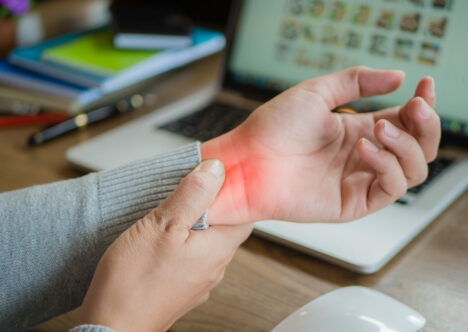Use our convenient online scheduler to book an appointment now.

Have you ever experienced a clicking or locking sensation in your fingers or thumb, accompanied by pain and discomfort? If so, you might be dealing with a common condition known as trigger finger. In this article, we’ll dive into what trigger finger is, its underlying causes, its symptoms, and the various treatment options available.
What Is Trigger Finger?
In the realm of hand surgery, trigger finger is a sensation characterized by clicking, locking, and pain in any of your fingers or your thumb. This occurrence can stem from various factors. Typically, trigger finger presents as discomfort akin to pain in your hand. It might give rise to the sensation of fingers intermittently popping, affecting different sections of the digits.
What Causes Trigger Finger?
Trigger Finger typically occurs due to the swelling of tendons that extend into the fingers or thumb. To help illustrate this concept, consider the muscles in your forearm that extend into these tendons, guiding them into each finger and the thumb. These tendons are secured against the bones of the fingers and thumb by specialized tunnels known as pulleys. Think of these tendons as rope-like structures gliding seamlessly through these pulley tunnels.
However, when inflammation takes hold in the hand, particularly in the area where the fingers or thumb start, the tendons can become swollen. This swelling creates a bulging section in the tendon, much like a rope with a swollen segment. When this swollen tendon attempts to pass through the pulley tunnel, it can become trapped on one end, resulting in a popping sensation accompanied by pain. The cycle repeats as the tendon retreats and swells further, causing a clicking and locking sensation. This intricate process stems from the inflammation-induced swelling of the tendon, disrupting its smooth passage through the tunnels.
Taking Care of Trigger Finger
Addressing trigger finger involves a range of approaches, all aimed at tackling the core issue – inflammation. To effectively address this underlying problem, we explore various strategies. The initial step is to reduce finger movement, which can be achieved by using a splint. This measure aids in minimizing strain on the affected area.
Your surgeon will initially start your trigger finger treatment without surgery. Among these options include home remedies for trigger finger, such as the use of anti-inflammatory medications, which can relieve inflammation and its associated discomfort. For those seeking professional assistance, a hand surgeon’s office can specifically administer trigger finger injections to target and alleviate inflammation within the affected tendon.
Should these interventions not yield the desired results – if relief is temporary or the issue persists – surgery is a final recourse. This surgical option becomes particularly relevant after a series of injection treatments have been explored without achieving the intended outcomes.
Is Trigger Finger Surgery Painful?
Should you reach the point where surgery for trigger finger becomes a consideration, apprehensions about the process and potential discomfort may arise. However, it’s important to note that trigger finger release surgery is typically conducted with patients fully awake. Here’s a breakdown of the procedure:
To ensure your comfort during the surgery, the area to be operated on is numbed using injections. These injections might cause some initial discomfort as they involve small pokes, but once administered, the pain sensation subsides. While you may still feel a sense of pressure – akin to someone applying pressure on your fingers – the sharp pain associated with cutting is absent. It’s worth noting that the injections for numbing medicine are likely the most uncomfortable part of the process.
During the surgery, you remain awake and can converse with your surgeon and the medical staff in the operating or procedure room. This setup allows for communication and collaboration throughout the procedure. While it’s natural to have concerns, understanding the awake surgery process can help alleviate any worries about undergoing trigger finger surgery.
How Long Does it Take to Recover from Trigger Finger Surgery?
Trigger finger surgery recovery time involves allowing the wound to heal. Remarkably, you can resume certain activities, such as typing and work-related tasks, on the same day as the surgery. This particularly applies to the majority of patients. The conscious choice to remain awake during the procedure also affords the convenience of driving yourself to the surgical center and back home.
As you embark on your recovery journey, the key focus is on wound healing. For the initial two weeks, it’s advisable to avoid lifting heavy objects, allowing the wound ample time to mend. Additionally, refraining from submerging the hand in pools or Jacuzzis for about a month is recommended to facilitate the complete healing of the wound.
Encouragingly, a notable degree of wound healing typically occurs within two days to a week post-surgery. Physical therapy can also help the recovery process. This short span encompasses the most critical phase of recovery. However, it’s important to underscore that our recommendations extend beyond wound healing alone, as we provide additional guidance to ensure a comprehensive and successful recovery process.
Conclusion
If you are seeking surgery for trigger finger, Town Center Orthopaedics’ team of experienced orthopedic specialists offers a range of non-invasive and surgical interventions to address the underlying causes of trigger finger and alleviate the associated pain and discomfort. To meet with our orthopedic experts, call (571) 250-5660 or request an appointment.
Join our Mailing List
TCO provides patients with orthopedic problems the trusted resources and patient-centered advice they need to “Feel Better. Move Better. Be Better.”
© 2024 Town Center Orthopaedics | All Rights Reserved


